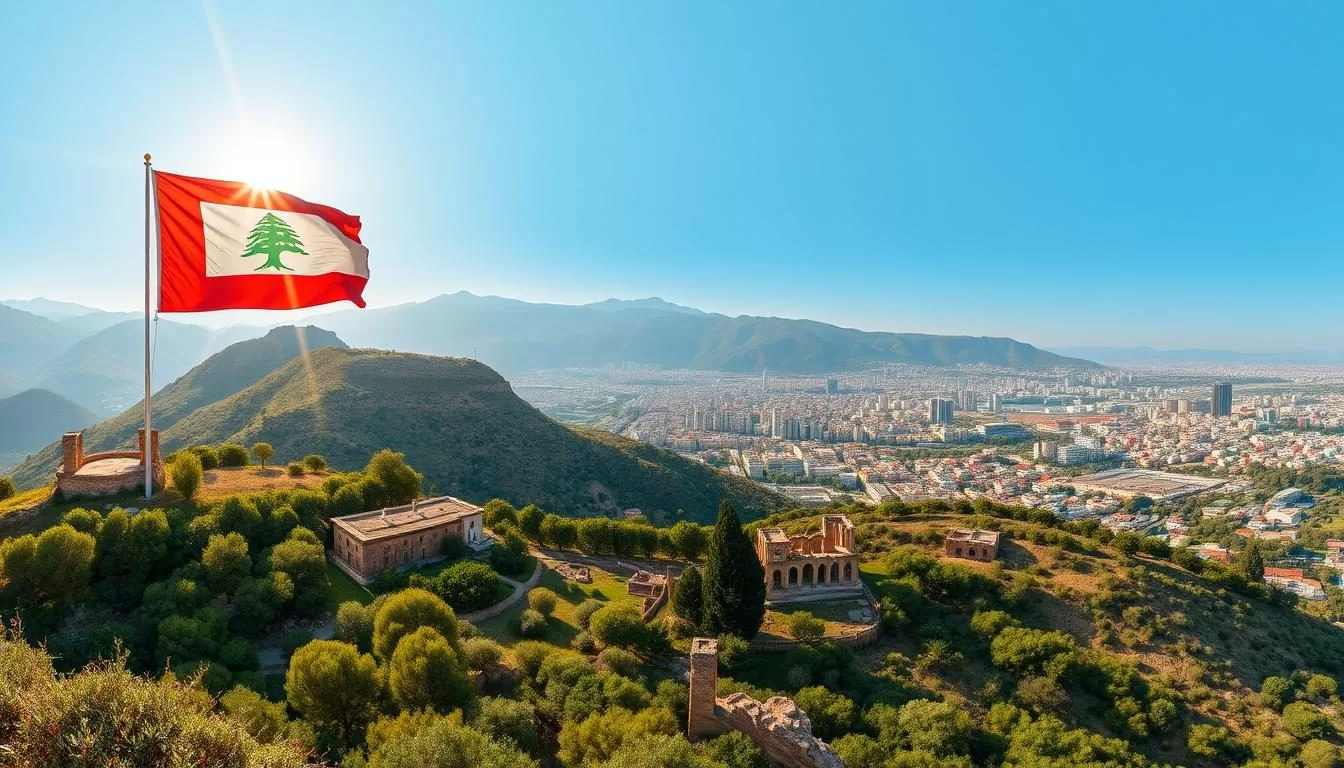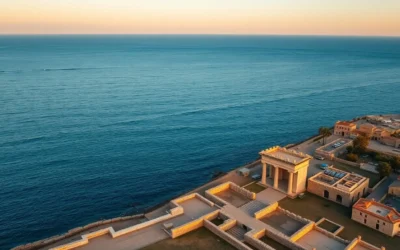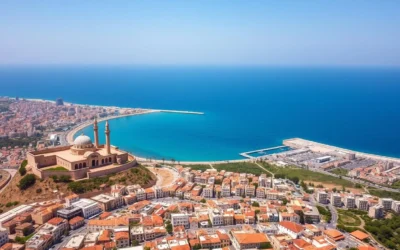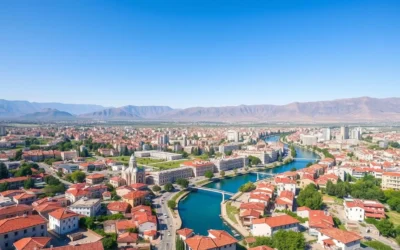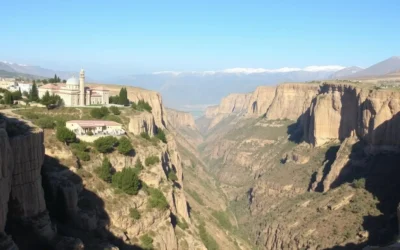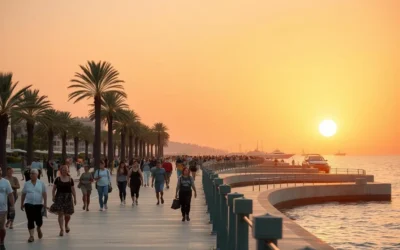✓ Accommodations✓ Flights✓ Rental Cars✓ Tours & Activities
Lebanon is a country known for its rich linguistic tapestry. The official language is Modern Standard Arabic, used in formal settings like media and government. However, in everyday conversations, Lebanese Arabic takes center stage, reflecting the vibrant local culture.
French plays a significant role here, often seen on road signs and official documents. This is due to historical ties that have shaped the nation’s identity. Meanwhile, English is gaining popularity, especially among younger generations and in higher education.
This multilingual environment creates a unique language landscape. Understanding it helps you appreciate the cultural heritage of this diverse country. Whether you’re exploring its history or connecting with locals, knowing the linguistic nuances enriches your experience.
Introduction to Lebanon’s Linguistic Landscape
Step into a world where language tells the story of a rich and diverse heritage. This nation’s linguistic scene is shaped by centuries of history, blending ancient roots with modern influences.
From the Phoenician period to today, the evolution of language reflects the nation’s identity. It’s a journey that highlights the resilience and adaptability of its community.
What You Will Discover
You’ll explore how formal and everyday language uses coexist. This duality is a key feature of the linguistic landscape here.
Education and media play a significant role in shaping this dynamic. For example, 50% of students studied in French in 2019, a shift from previous years.
Setting the Cultural Context
The population here embraces multiple languages, creating a unique cultural identity. This multilingualism is evident in daily life, from school to media.
Understanding this context helps you appreciate the depth of the nation’s heritage. It’s a story that continues to evolve with each passing year.
Understanding Lebanon: Official and widely spoken languages
The linguistic scene here showcases a fascinating mix of formal and informal communication. Modern Standard Arabic is the official language, used in government, media, and education. However, in daily life, people speak Lebanese Arabic, a dialect that reflects the region’s cultural vibrancy.
Modern Standard Arabic and Lebanese Arabic differ in structure and usage. The former is formal and written, while the latter is informal and spoken. This duality allows the population to navigate both traditional and modern contexts seamlessly.
Lebanese Arabic shares high mutual intelligibility with other Levantine varieties. This makes it easier for speakers from neighboring regions to understand each other. The shared roots of these dialects strengthen cultural ties across the Levant.
Language plays a key role in shaping national and cultural identity. Code-switching between Arabic, French, and English is common. This reflects the region’s historical influences and modern global connections.
| Language | Usage |
|---|---|
| Modern Standard Arabic | Formal settings, education, media |
| Lebanese Arabic | Daily conversations, informal communication |
| French | Legal documents, education, cultural influence |
| English | Higher education, technology, global communication |
Understanding these linguistic nuances helps you appreciate the region’s rich heritage. Whether you’re exploring its history or connecting with locals, language is a gateway to deeper cultural insights.
Historical Evolution of Language in Lebanon
From ancient roots to modern influences, the linguistic journey is fascinating. The region’s language has been shaped by centuries of cultural exchange and historical events. Understanding this evolution helps you appreciate the depth of its heritage.
From Phoenician to Aramaic
The earliest roots trace back to the Phoenician period, around 1200 BCE. This ancient language laid the foundation for communication in the region. By 900 AD, Aramaic became dominant, influencing vocabulary and grammar.
Approximately 40% of Arabic vocabulary today has Aramaic origins. This blend of languages created a unique linguistic family. It reflects the adaptability of the population over time.
Impact of Ottoman and French Eras
During the Ottoman era (1516-1918), Turkish words entered the local lexicon. This period added new layers to the region’s language. Words related to administration and daily life were adopted.
The French mandate (1920-1943) brought another wave of change. French became a key language in education and legal systems. Today, 40% to 50% of the population speaks French.
| Period | Language Influence |
|---|---|
| 1200 BCE | Phoenician roots |
| 900 AD | Aramaic dominance |
| 1516-1918 | Ottoman Turkish vocabulary |
| 1920-1943 | French mandate influence |
These historical shifts have left a lasting mark on the way people communicate. The language continues to evolve, blending ancient and modern elements. This rich heritage is a testament to the region’s resilience.
Diglossia and Everyday Communication
Communication in this region is shaped by a unique linguistic phenomenon. Known as diglossia, it involves using two forms of the same language in different contexts. This duality is a key feature of daily life here.
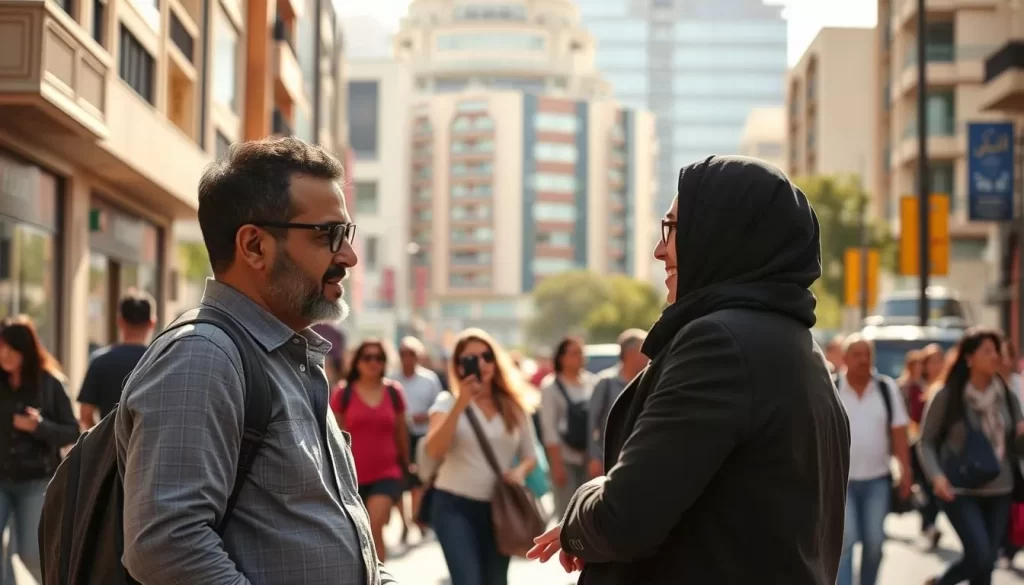
Modern Standard Arabic vs. Lebanese Arabic
Modern Standard Arabic is the formal language used in media, education, and official documents. It’s a unifying factor across the Arab world. However, in everyday conversations, people switch to Lebanese Arabic, a dialect that’s more relaxed and expressive.
These two forms differ in structure and usage. Modern Standard Arabic is precise and structured, while Lebanese Arabic is fluid and adaptable. This allows people to navigate both formal and informal settings with ease.
The Role of Code-Switching
Code-switching is a common practice here. People often mix Arabic, French, and English in a single conversation. For example, you might hear phrases like “Je vais faire un meeting” (I’m going to have a meeting) or “Let’s yalla!” (Let’s go!).
This bilingual or trilingual interplay reflects the region’s historical influences and modern global connections. It’s not just about convenience—it’s a way to express identity and cultural pride.
| Language Form | Context |
|---|---|
| Modern Standard Arabic | Formal settings, education, media |
| Lebanese Arabic | Daily conversations, informal communication |
| French/English Mix | Code-switching in professional and social settings |
This dynamic language landscape shapes how people interact in public and professional life. Whether in a business meeting or a casual chat, the ability to switch between forms of speech is a valuable skill.
Bilingualism and Multilingualism in Education and Media
Education and media in this region thrive on a multilingual foundation, blending tradition with modern global influences. This unique approach shapes how people learn, communicate, and express themselves daily.
Language Use in Schools and Universities
In schools, students often learn in two or three languages. Since 1997, most state schools have taught the curriculum in English or French. Private schools, which educate 70% of children, further emphasize these languages.
This multilingual system enhances cognitive skills and cultural awareness. A study found that 75% of teachers believe it boosts student engagement and motivation. Students in bilingual settings also outperform peers in standardized tests by 15%.
Media, Films, and Music
Media production reflects this linguistic diversity. Films and TV shows often use Lebanese Arabic alongside Modern Standard Arabic. This blend creates relatable content while maintaining cultural authenticity.
Music is another area where multiple languages shine. Artists frequently mix Arabic, French, and English lyrics. This approach appeals to a broader audience and showcases the region’s global connections.
Bilingualism and multilingualism offer clear advantages in the job market. Professionals who can switch between languages are highly valued. This skill opens doors to international opportunities and fosters cultural understanding.
The Influence of French and English in Lebanon
The blend of French and English in daily life reflects a fascinating cultural evolution. These languages have left a lasting mark on communication, shaping how people interact in both formal and informal settings. From education to media, their presence is undeniable.
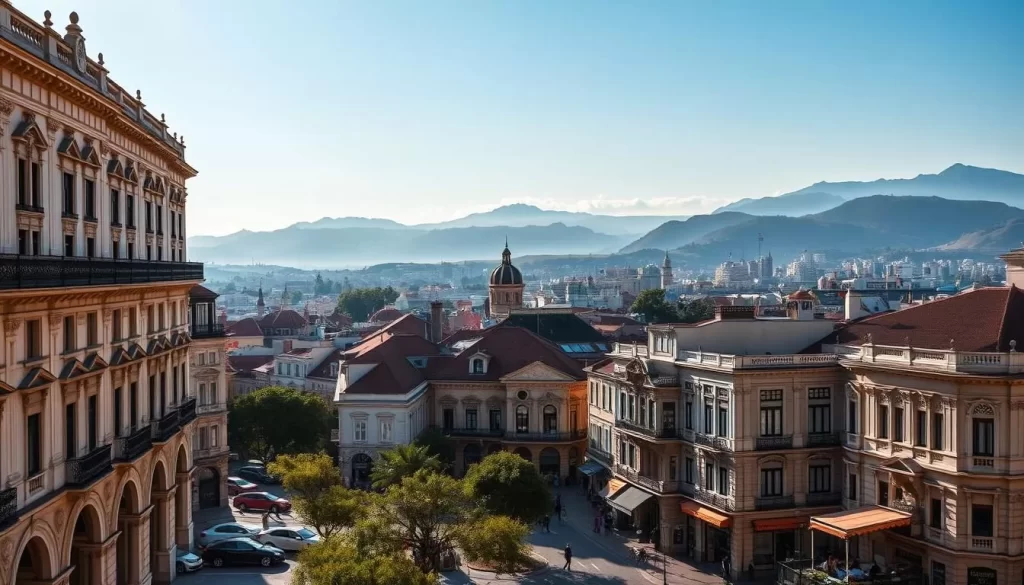
Legacy of the French Mandate
French became deeply rooted during the mandate period (1920-1943). Today, it remains a dominant language in education, with 70% of secondary schools using it as a second language of instruction. You’ll also find it on road signs, banknotes, and public buildings, showcasing its ongoing legacy.
Approximately 40% of the population is Francophone, and 15% are considered partial francophones. This widespread use highlights how historical ties continue to influence modern life.
Rise of English in Daily Interactions
English has gained significant traction, especially among younger generations. In Beirut, nearly 75% of citizens report speaking French or English. This rise is evident in education, where one-third of high school students educated in French pursue higher studies in English-speaking institutions.
Code-switching between french english and Lebanese Arabic is common. Phrases like “Je vais faire un meeting” (I’m going to have a meeting) reflect this linguistic blend. It’s not just about convenience—it’s a way to express identity and global connections.
These languages shape youth culture and education, offering a unique perspective on the region’s heritage. Whether in classrooms or casual conversations, their influence is everywhere.
Regional Language Diversity and Minority Voices
Beyond the dominant tongues, a mosaic of regional dialects and minority languages enriches the cultural fabric. These voices add depth to the identity of the community, preserving traditions and fostering inclusivity.
Armenian, Kurdish, and Other Influences
Western Armenian and Kurdish are among the minority languages spoken here. Armenian, in particular, is used by about 4% of the population, reflecting the heritage of the Lebanese Armenian family. Kurdish, though less prevalent, is another thread in this linguistic tapestry.
These languages are more than just communication tools. They are a way for persons to connect with their roots and pass down cultural stories. Schools and media outlets often feature these languages, ensuring they remain alive for future generations.
Sign Language and the Deaf Community
Sign language plays a vital role in the lives of the deaf community. It’s not just a means of communication but a bridge to inclusion. Efforts to promote sign language in education and media are growing, making it more accessible to everyone.
For example, some schools now offer sign language classes, helping students connect with their peers. This inclusivity strengthens the bonds within the community, fostering a sense of belonging.
| Language | Role |
|---|---|
| Western Armenian | Cultural preservation, education |
| Kurdish | Heritage, regional identity |
| Sign Language | Inclusion, communication for the deaf |
These minority voices contribute to the vibrant identity of the Lebanese people. Whether through education, media, or daily interactions, they ensure that every person feels seen and heard. This diversity is a testament to the resilience and adaptability of the community.
Language and Identity in Everyday Life
Language is a mirror of identity, reflecting who you are and where you belong. For a person in this region, the way you speak connects you to your roots and shapes your sense of self. Whether you’re using Modern Standard Arabic in formal settings or Lebanese Arabic in casual chats, each word carries a piece of your story.
Code-switching is a natural part of daily life here. You might start a sentence in Arabic, sprinkle in some French, and finish with English. This linguistic dance isn’t just about convenience—it’s a way to express your unique identity. Phrases like “Je vais faire un meeting” (I’m going to have a meeting) show how seamlessly languages blend in your routine.
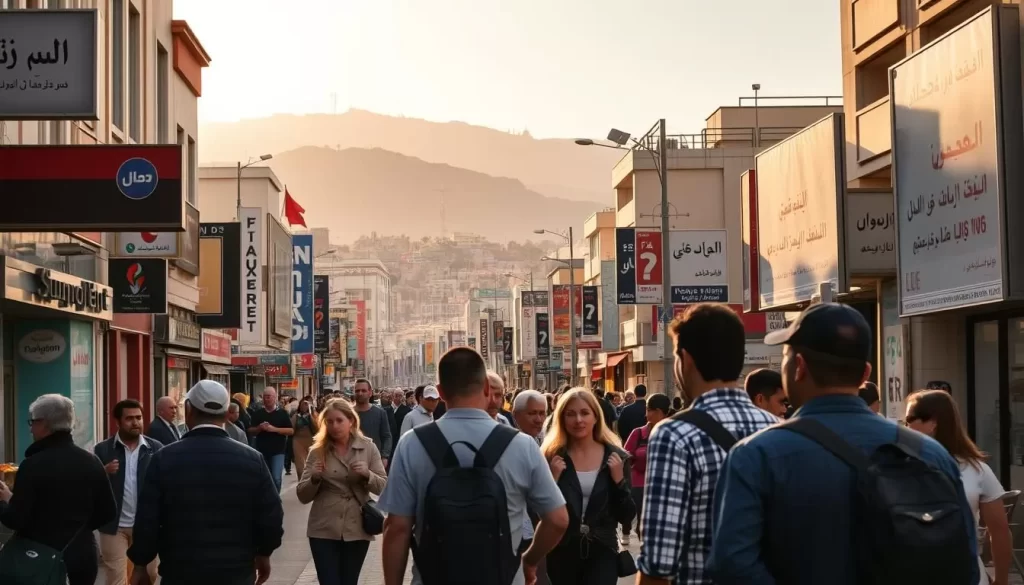
This multilingual environment fosters a strong sense of community. When you share a language, you share a bond. It’s why family gatherings often feature a mix of Arabic, French, and English. These conversations aren’t just about words—they’re about preserving traditions and creating connections.
Language also bridges the gap between heritage and modern life. For example, while younger generations might prefer English for technology and global communication, they still use Lebanese Arabic to connect with older family members. This balance keeps cultural roots alive while embracing progress.
“Language is the road map of a culture. It tells you where its people come from and where they are going.”
In this region, language is more than a tool for communication—it’s a living part of the culture. It shapes how you see yourself and how you relate to others. Whether you’re speaking at home, at work, or in social settings, your words are a testament to the rich tapestry of your identity. This unique polyglotism is what makes the community so vibrant and diverse.
How You Benefit from Exploring Lebanon’s Language Diversity
Exploring linguistic diversity opens doors to cultural richness and global understanding. When you dive into different languages, you gain insights that enrich your travel experiences and broaden your worldview. This exploration is not just about words—it’s about connecting with people and their stories.
Cultural Insights for Travelers
When you travel, understanding the local language can transform your experience. It allows you to connect with the population on a deeper level, making your journey more meaningful. For example, knowing a few phrases in Lebanese Arabic can help you navigate markets, ask for directions, and engage in conversations with locals.
Parents often enroll their children in schools that teach multiple languages, believing it will benefit their future. This trend reflects the importance of linguistic diversity in shaping cultural identity. By learning a new language, you not only communicate better but also gain a deeper appreciation for the culture.
Enhancing Your Global Perspective
Language learning goes beyond travel—it enhances your global perspective. In a world where 300 million people speak Arabic as their native language, understanding it can open doors to new opportunities. Whether in education, business, or media, being multilingual is a valuable skill.
In schools, 83.3% of principals provide students with two hours of English instruction daily, highlighting its importance in a globalized world. This bilingual approach prepares students for international careers and fosters cultural understanding. By exploring linguistic diversity, you equip yourself with tools to thrive in a connected world.
| Benefit | Impact |
|---|---|
| Cultural Connection | Deepens travel experiences and fosters meaningful interactions |
| Global Opportunities | Enhances career prospects and international understanding |
| Personal Growth | Boosts cognitive skills and cultural awareness |
Exploring linguistic diversity is more than an academic pursuit—it’s a journey that enriches your life. Whether you’re traveling, studying, or working, understanding different languages connects you to the world in profound ways. Start your journey today and discover the endless possibilities that await.
For more insights into the unique aspects of Lebanese Arabic, check out this detailed guide.
Modern Standard Arabic in Government and Law
Modern Standard Arabic plays a pivotal role in shaping governance and legal systems. As the official language, it is used in all government documents, road signs, and legal proceedings. This ensures consistency and clarity in formal communication across the country.
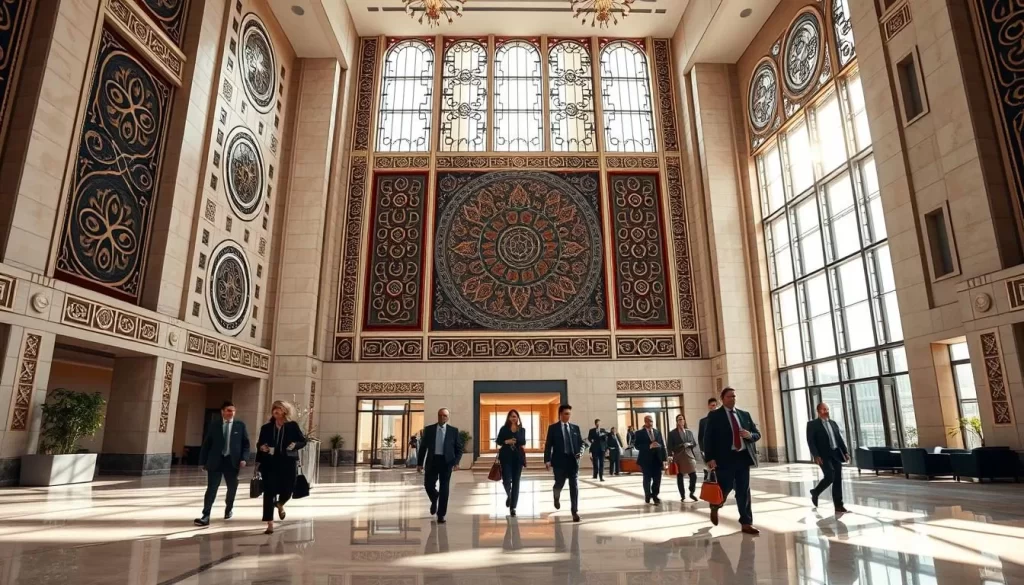
Official Documents and Communication
In legal settings, Modern Standard Arabic is the primary language for written documents. However, verbal communication in courts often blends it with Lebanese Arabic. This mix allows for precise legal terminology while maintaining accessibility for all parties involved.
Public services also rely heavily on Modern Standard Arabic. From birth certificates to property deeds, every official record is maintained in this formal language. This practice ensures uniformity and reduces misunderstandings in administrative processes.
Language Policies in Education
In schools, students are taught Modern Standard Arabic as part of the curriculum. This formal instruction prepares them for roles in government, law, and other professional fields. However, everyday conversations often switch to regional dialects, creating a balance between formal and informal language use.
This dual approach helps students navigate both formal and casual settings with ease. It also preserves cultural identity while equipping them with skills for national and international communication.
Understanding the role of Modern Standard Arabic in governance and law gives you insight into the country’s linguistic framework. It highlights how language shapes identity, public services, and education, creating a cohesive national image.
Lebanese Language in the Context of Global Media
The global media landscape is shaped by the unique linguistic blend of Lebanese Arabic and Modern Standard Arabic. This duality allows for a rich cultural expression that resonates both locally and internationally. Whether in films, television, or news, the language reflects the region’s vibrant identity.
In television and films, Lebanese Arabic is often used for its relatability and cultural authenticity. Meanwhile, Modern Standard Arabic appears in formal broadcasts, ensuring clarity and consistency. This balance helps project the region’s culture to the world, making it accessible to diverse audiences.
For example, popular TV networks like LBCI and Al Jadeed use Lebanese Arabic in entertainment shows. News bulletins, however, switch to Modern Standard Arabic for formal reporting. This dual approach highlights the adaptability of the media in catering to different contexts.
Film dubbing practices also showcase this linguistic blend. International movies are often dubbed into Modern Standard Arabic for wider appeal. At the same time, local productions use Lebanese Arabic to connect with audiences on a personal level. This strategy strengthens cultural ties while embracing global influences.
Innovations like sign language are also gaining traction in media. Programs now include sign language interpreters, making content more inclusive. This modern approach ensures that everyone, regardless of hearing ability, can engage with the world of media.
Understanding the role of language in media helps you appreciate its cultural significance. Whether through films, TV, or news, the linguistic choices reflect a deep connection to heritage and modernity. Explore more about the influence of English in Lebanese media to see how global languages shape this dynamic landscape.
Conclusion
Language shapes how we connect with the world around us. In this diverse environment, it reflects identity, culture, and daily life. From historical roots to modern influences, the evolution of communication highlights the resilience of the population.
Understanding this multilingual landscape offers practical benefits. It bridges gaps between heritage and modernity, fostering inclusivity. Whether in education, media, or everyday situations, language plays a vital role in shaping connections.
Keep exploring this rich linguistic tapestry. Dive deeper into how it influences both local and global situations. Your journey into understanding language is a step toward appreciating cultural diversity. Learn more about the shifting dynamics of language in this and continue your exploration.
The above is subject to change.
Check back often to TRAVEL.COM for the latest travel tips and deals.
